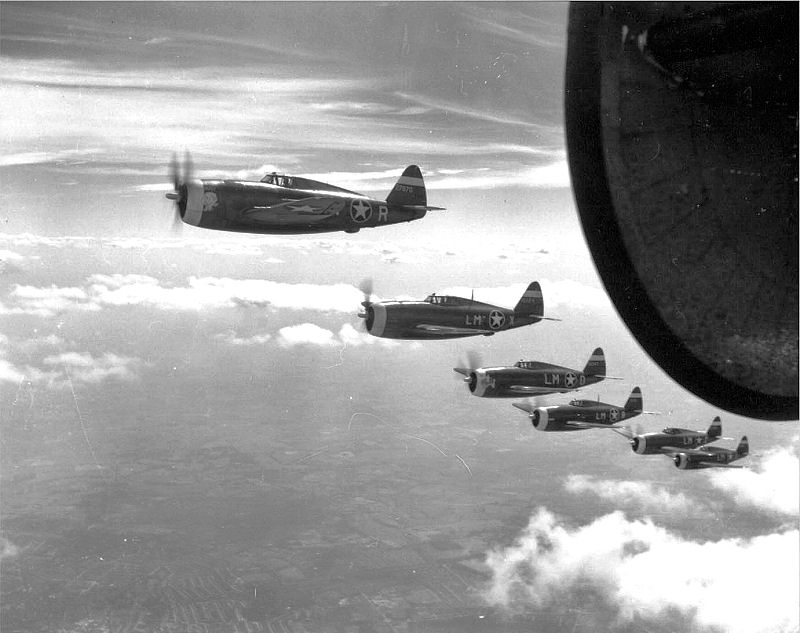There were never any P-47 dual-seat trainers produced, and some pilots considered the step up in performance from the Texan to the Thunderbolt to be too difficult to handle
The massive Republic P-47 was one of the most famous and significant USAAF fighters during World War II and was renowned for its toughness, firepower, and speed. The Thunderbolt, popularly known as the “Jug,” was produced in greater quantities than any other American fighter and was used as both a bomber escort and a powerful ground attack aircraft.
The P-47D was the most produced and widely deployed variant of the Thunderbolt, having been created in more than 12,500 units. The P-47 was employed by the USAAF and several Allies in almost all combat zones. The majority of the 8th Air Force fighter groups in England (and one in the 15th Air Force in Italy) were outfitted with P-47C and P-47D long-range escort fighters throughout 1943 in Europe.
In New Guinea and the Philippines in 1943–1944, several 5th Air Force fighter groups employed the P-47D against Japanese air and ground forces.
According to Michael John Claringbould’s P-47D Thunderbolt vs. Ki-43-II Oscar NEW GUINEA 1943–1944 book, The USAAF was under a lot of pressure during the first 18 months of the war. The system was compelled to prioritize “quantity rather than quality” because of the high demand for pilots in 1942–1943; Allied training did not catch up to German and Japanese training in terms of duration or overall quality until the early months of 1943.
Most of the P-47 pilots that engaged in combat over New Guinea starting in the middle of 1943 were members of the USAAF’s pilot training program run by Technical Training Command and Flying Training Command. The four stages of instruction began with Primary Flight Training, where students logged 65 hours on trainer aircraft such as the 220 horsepower PT-13 Stearman biplane or the 200 horsepower PT-19 Cornell monoplane.
The program was divided into four sections. The pre-solo part of the typical primary school flight program included the general operation of a light aircraft, mastery of landing techniques, and recovery from stalls and spins. Pre-solo flying exercises such as “elementary 8s,” “lazy 8s,” “pylon 8s,” and “chandelles” were part of the second phase. Developing a high level of expertise in landing approaches and landings was the focus of the third phase. Aerobatics was the topic of the fourth phase. Before continuing, each cadet had to complete at least 175 landings. Then, on 450hp BT-13/15 Valiant basic trainers, the student completed 70 hours of basic flight training.
The following phase was advanced flight training, a ten-week program that included 75 hours of flying, 60 hours of ground training, and 19 hours of military instruction. The 600hp AT-6 Texan, the most powerful aircraft in the training program, was used for flying. The student would receive his silver pilot’s wings and the rank of flight officer or be commissioned as a second lieutenant after successfully completing advanced flight training.
From December 1942 pilots had two months of transition flying instruction with a Fighter Replacement Training Unit. Here, they gained experience flying the early models of the frontline fighter they would use in battle. For a rookie pilot, the transition from the 600-horsepower AT-6 to a monster like the 2,000-horsepower P-47 Thunderbolt was significant and terrifying. Crash rates were way too high and there were no dual trainers. The training was strict and unforgiving by today’s safety standards, and in some ways, it had to be. The cost was exorbitant, as thousands of lives were lost while learning to fly some of the most lethal and deadliest fighters in existence. According to the USAAF, there were 52,651 training accidents in which 14,903 people lost their lives and 13,873 aircraft were written off.
Pilots were assigned to unit training groups or chosen as replacements for squadrons that were already on the front lines after completing 200 hours of flight time and nine months of flying training.
P-47D Thunderbolt vs Ki-43-II Oscar NEW GUINEA 1943–44 is published by Osprey Publishing and is available to order here.

Photo by IWM and U.S. Army Air Forces

